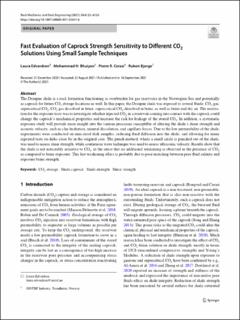| dc.contributor.author | Edvardsen, Laura | |
| dc.contributor.author | Bhuiyan, Mohammad Hossain | |
| dc.contributor.author | Cerasi, Pierre | |
| dc.contributor.author | Bjørge, Ruben | |
| dc.date.accessioned | 2022-04-29T08:12:36Z | |
| dc.date.available | 2022-04-29T08:12:36Z | |
| dc.date.created | 2021-09-16T15:34:17Z | |
| dc.date.issued | 2021 | |
| dc.identifier.citation | Rock Mechanics and Rock Engineering. 2021, 54 6123-6133. | en_US |
| dc.identifier.issn | 0723-2632 | |
| dc.identifier.uri | https://hdl.handle.net/11250/2993336 | |
| dc.description.abstract | The Draupne shale is a rock formation functioning as overburden for gas reservoirs in the Norwegian Sea and potentially as caprock for future CO2 storage locations as well. In this paper, the Draupne shale was exposed to several fluids: CO2 gas, supercritical CO2, CO2 gas dissolved in brine, supercritical CO2 dissolved in brine, as well as brine and dry air. The motivation for the exposure tests was to investigate whether injected CO2 in a reservoir coming into contact with the caprock could change the caprock’s mechanical properties and increase the risk for leakage of the stored CO2. In addition, a systematic exposure study will provide more insight into the various processes susceptible of altering the shale’s shear strength and acoustic velocity, such as clay hydration, mineral dissolution, and capillary forces. Due to the low permeability of the shale, experiments were conducted on mm-sized disk samples, reducing fluid diffusion into the shale, and allowing for many repeated tests on disks close by in the original core. The punch method, where a small circle is punched out of the shale, was used to assess shear strength, while continuous wave technique was used to assess ultrasonic velocity. Results show that the shale is not noticeably sensitive to CO2, in the sense that no additional weakening is observed in the presence of CO2 as compared to brine exposure. This last weakening effect is probably due to poor matching between pore fluid salinity and exposure brine strength. | en_US |
| dc.language.iso | eng | en_US |
| dc.publisher | Springer | en_US |
| dc.rights | Navngivelse 4.0 Internasjonal | * |
| dc.rights.uri | http://creativecommons.org/licenses/by/4.0/deed.no | * |
| dc.subject | Shear strength | en_US |
| dc.subject | Shale strength | en_US |
| dc.subject | Shale caprock | en_US |
| dc.subject | CO2 storage | en_US |
| dc.title | Fast Evaluation of Caprock Strength Sensitivity to Different CO2 Solutions Using Small Sample Techniques | en_US |
| dc.type | Peer reviewed | en_US |
| dc.type | Journal article | en_US |
| dc.description.version | publishedVersion | en_US |
| dc.rights.holder | © The Author(s) 2021 | en_US |
| dc.source.pagenumber | 6123-6133 | en_US |
| dc.source.volume | 54 | en_US |
| dc.source.journal | Rock Mechanics and Rock Engineering | en_US |
| dc.identifier.doi | 10.1007/s00603-021-02641-6 | |
| dc.identifier.cristin | 1935028 | |
| dc.relation.project | Norges forskningsråd: 268445 | en_US |
| cristin.ispublished | true | |
| cristin.fulltext | original | |
| cristin.qualitycode | 2 | |

